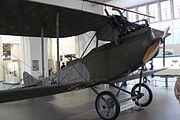| C.IV | |
|---|---|
| Role | Reconnaissance aircraft |
| Manufacturer | Rumpler Flugzeugwerke |
| Designer | Dr. Edmund Rumpler |
| Introduction | 1917 |
| Primary user | Luftstreitkräfte |
| Variants | Rumpler 6B-2 |
The Rumpler C.IV was a German single-engine, two-seat reconnaissance biplane. The C.IV was a development of C.III with different tail surfaces and using a Mercedes D.IVa engine in place of C.III's Benz Bz.IV. In addition to the parent company, the aircraft was also built by Pfalz Flugzeugwerke as the Pfalz C.I. Another variant of the basic design was the Rumpler 6B-2 single-seat floatplane fighter, with a 120 kW (160 hp) Mercedes D.III engine, built for the Kaiserliche Marine (Imperial Navy).
For a two-seater reconnaissance aircraft, Rumpler C.IV had an excellent performance, which enabled it to remain in front-line service until the end of World War I on the Western Front, as well as in Italy and Palestine. Its exceptional ceiling allowed pilots to undertake reconnaissance secure in the knowledge that few allied aircraft could reach it.
For use during filming, Slingsby Sailplanes built two Slingsby T.58 Rumpler C.IV replicas. While these were visually similar to the original aircraft, they were structurally completely different, having a steel-tube fuselage structure and wooden wings, and being powered by a de Havilland Gipsy Major engine.[1]
Operators[]
- Yugoslav Royal Air Force - Postwar.
Specifications (C.IV)[]

Rumpler C.IV as seen in Deutsches Museum

Rumpler C.IV inside visible
Data from German Aircraft Of The First World War [2]
General characteristics
- Crew: 2, pilot and observer
- Length: 8.41 m. (27 ft 7 in.)
- Wingspan: 12.66 m. (41 ft 6½ in.)
- Height: 3.25 m. (10 ft 8 in.)
- Wing area: 33.5 m² (361.8 ft)
- Empty weight: 1,080 kg (2,376 lb)
- Loaded weight: 1,530 kg (3,366 lb)
- Powerplant: 1 × Mercedes D.IVa water-cooled in-line, 194 kW (260 hp)
Performance
- Maximum speed: 171 km/h (92 kn, 107 mph) at 500 m (1,640 ft)
- Service ceiling: 6,400 m [3] (21,000 ft)
- Wing loading: kg/m² (lb/ft²)
- Endurance: 3½-4 hr
Armament
See also[]
References[]
Notes[]
Bibliography[]
- Gray, Peter and Thetford, Owen. German Aircraft of the First World War. London, Putnam, 1962.
- Munson, Kenneth. Aircraft of World War I. London: Ian Allan, 1967. ISBN 0-7110-0356-4.
- Munson, Kenneth. Bombers, Patrol and Reconnaissance Aircraft 1914 - 1919. ISBN 0-7537-0918-X
- Munson, Kenneth. Fighters, Attack and Training Aircraft 1914 - 1919. ISBN 0-7537-0916-3.
- Taylor, John W. R. Jane's All The World's Aircraft 1969–70. London: Sampson Low, Marston & Company, 1969. ISBN 0-354-00051-9.
External links[]
| Wikimedia Commons has media related to Rumpler aircraft. |
- A page about Max Psaar, an ethnic Sorbian Rumpler C.IV pilot of Luftstreitkräfte (in German).
- Page on Rumpler C.IV on website Deutsches museum
| |||||||||||
The original article can be found at Rumpler C.IV and the edit history here.
